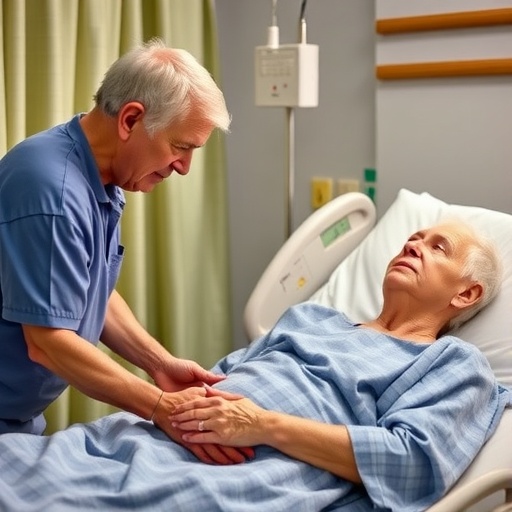Raul Silva lived with phantom limb pain for 18 years until a new dorsal root ganglion (DRG) device erased his pain during a test phase at UC San Diego Health, one of the only providers in the region offering the device
Credit: UC San Diego Health
In May 2000, Raul Silva was involved in a motorcycle accident in Baja California, Mexico, badly breaking his left femur, or thighbone. He underwent emergency surgery in Mexicali and, at first, everything seemed fine. Then an infection set in, worsened, and Silva eventually made his way to San Diego, where his left leg was amputated.
“When I left the hospital and came home, I didn’t really know anything about phantom limb pain,” Silva said, who now lives in Calexico, Calif. “But I felt it immediately, like a pinch in my toe and knee, even though they weren’t there anymore. It quickly became the worst pain I’ve ever experienced. Taking just one step, even while wearing a prosthetic device, was painful. But there wasn’t anything I could do — there isn’t anything there to ice, heat or massage.”
For years, all Silva’s doctors could do was tell him to take aspirin and, more recently, prescription gabapentin and opioids to relieve the pain. He said the medications made him sleepy and didn’t really help a lot, but something was better than nothing. Silva worked in retail for many years, which he said helped distract him from the pain, but it was always there. He stopped working altogether in 2015 when his phantom limb pain became too much to bear.
A few months ago, a doctor referred Silva to Krishnan Chakravarthy, MD, PhD, a pain management specialist at UC San Diego Health, a two-hour drive from Silva’s home. Chakravarthy is one of just a handful of San Diego physicians who have undergone specialized training to implant a new pain management device, Abbot’s Proclaim™ DRG Neurostimulator System for dorsal root ganglion (DRG) stimulation.
The DRG is a bundle of sensory nerves that transmits information to the brain. The new device stimulates the DRG, disrupting the transmission of pain signals. The battery-powered device is implanted in a patient’s back, where it sends out mild electrical pulses through thin wires connected to the DRG. The device communicates with a handheld, iPad-like device via Bluetooth wireless technology, allowing the patient to control the strength of the stimulation.
DRG therapy is designed for people with untreatable complex regional pain syndrome in the lower limbs, a condition that typically results from an injury or surgery. This type of pain can be so debilitating and life-changing that patients sometimes refer to it as “the suicide disease.”
Under Chakravarthy’s care, Silva became UC San Diego Health’s first patient to test the device. In October 2018, he had a temporary device placed for a one-week testing phase. During that time, Silva said his pain completely disappeared. For the first time in 18 years, he actually felt like an amputee because he could no longer feel the phantom leg. Silva could wear his prosthetic leg without any pain or discomfort, making it much easier for him to get around. His sciatic pain went away, too. He didn’t feel the need to take any pain medication.
“It was heaven,” Silva said. “This is the best thing to happen to me since the amputation.”
The DRG stimulation device is similar to traditional spinal cord stimulators, in which an implanted device stimulates the spinal cord. But the spinal cord is surrounded by more cerebral spinal fluid than the DRG, and that can disrupt the current and cause unwanted stimulation or motor activation. The DRG is predictably located at each spinal level, allowing health care providers to treat a broader range of pain types and specifically target the painful region. The DRG stimulation device’s Bluetooth capabilities also give patients more control over their pain management.
Unlike previous generations of neurostimulators, the new DRG device is compatible with magnetic resonance imaging (MRI). And while many patients with traditional spinal cord stimulators need to spend 45 minutes per day charging batteries, the DRG device doesn’t need to be recharged, thanks to a special battery that holds a large, single charge. Additionally, the DRG only requires very small doses of energy to treat pain.
In a randomized trial, 74 percent of patients who received DRG stimulation achieved meaningful pain relief and greater treatment success, compared to 53 percent of patients who received traditional spinal cord stimulation. Those results were published April 2017 in the journal Pain.
“With DRG stimulation, I think we’ll finally be able to bring relief to many patients with chronic lower limb pain who haven’t responded to medications or spinal cord stimulation,” Chakravarthy said. “So far, the results we’ve seen are amazing.”
Silva is looking forward to having Chakravarthy implant the DRG stimulation device permanently.
“I’d rather try something new than do nothing,” he said. “And someone has to be first to do something new, so others can benefit. I hope my experience can help others know that they aren’t the only ones living in pain, and that there are options like this.”
###
For more information, visit health.ucsd.edu/specialties/pain
Media Contact
Heather Buschman
[email protected]
858-249-0456




